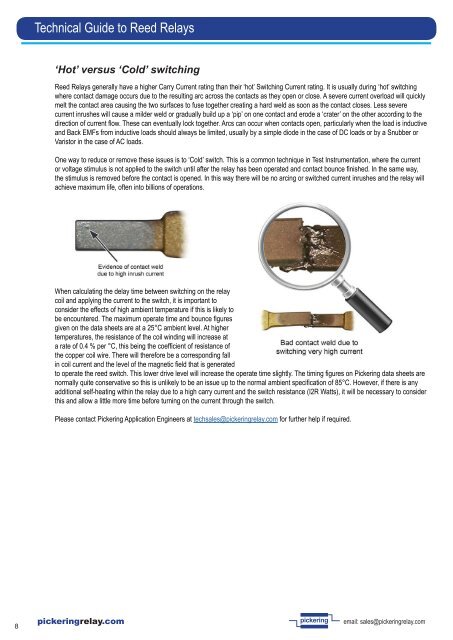Pickering Electronics Catalog Jan17
You also want an ePaper? Increase the reach of your titles
YUMPU automatically turns print PDFs into web optimized ePapers that Google loves.
Technical Guide to Reed Relays<br />
‘Hot’ versus ‘Cold’ switching<br />
Reed Relays generally have a higher Carry Current rating than their ‘hot’ Switching Current rating. It is usually during ‘hot’ switching<br />
where contact damage occurs due to the resulting arc across the contacts as they open or close. A severe current overload will quickly<br />
melt the contact area causing the two surfaces to fuse together creating a hard weld as soon as the contact closes. Less severe<br />
current inrushes will cause a milder weld or gradually build up a ‘pip’ on one contact and erode a ‘crater’ on the other according to the<br />
direction of current flow. These can eventually lock together. Arcs can occur when contacts open, particularly when the load is inductive<br />
and Back EMFs from inductive loads should always be limited, usually by a simple diode in the case of DC loads or by a Snubber or<br />
Varistor in the case of AC loads.<br />
One way to reduce or remove these issues is to ‘Cold’ switch. This is a common technique in Test Instrumentation, where the current<br />
or voltage stimulus is not applied to the switch until after the relay has been operated and contact bounce finished. In the same way,<br />
the stimulus is removed before the contact is opened. In this way there will be no arcing or switched current inrushes and the relay will<br />
achieve maximum life, often into billions of operations.<br />
When calculating the delay time between switching on the relay<br />
coil and applying the current to the switch, it is important to<br />
consider the effects of high ambient temperature if this is likely to<br />
be encountered. The maximum operate time and bounce figures<br />
given on the data sheets are at a 25°C ambient level. At higher<br />
temperatures, the resistance of the coil winding will increase at<br />
a rate of 0.4 % per °C, this being the coefficient of resistance of<br />
the copper coil wire. There will therefore be a corresponding fall<br />
in coil current and the level of the magnetic field that is generated<br />
to operate the reed switch. This lower drive level will increase the operate time slightly. The timing figures on <strong>Pickering</strong> data sheets are<br />
normally quite conservative so this is unlikely to be an issue up to the normal ambient specification of 85°C. However, if there is any<br />
additional self-heating within the relay due to a high carry current and the switch resistance (I2R Watts), it will be necessary to consider<br />
this and allow a little more time before turning on the current through the switch.<br />
Please contact <strong>Pickering</strong> Application Engineers at techsales@pickeringrelay.com for further help if required.<br />
8<br />
pickeringrelay.com<br />
pickering<br />
email: sales@pickeringrelay.com


